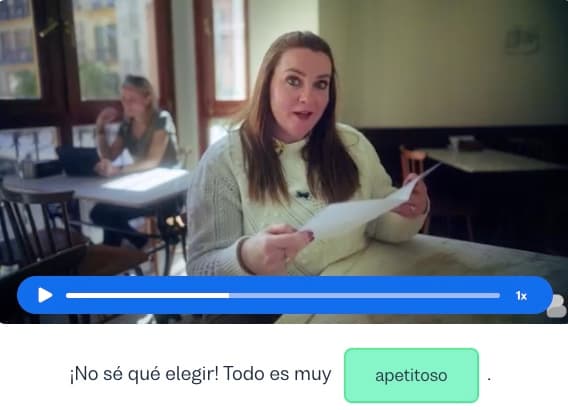I want to learn...
While you can be precise or detailed with every sentence, it runs the risk of sounding a bit robotic and stiff. No worries. We can use relative pronouns in Spanish to sound more natural.
But how can we do this? Spanish has many relative pronouns, so for this lesson, we will focus on three common ones:que, quien, anddonde.
Let’s dive in!
All about relative pronouns in Spanish
Take a look at these English sentences:
Anna is a girl. I live with Anna.
Technically, both sentences are correct. But we rarely talk like this. Instead, we’re more likely to say:
Anna is the girl that I live with.
Much better!
We were able to achieve this by using a relative pronoun, in this case, “that”.
Note: We’re actually more likely to say, “Anna is the girl I live with” and skip “that” completely. While it’s ok to drop your relative pronouns in English, in Spanish you must always include them.
By now, we’re sure you know that there are many different types of Spanish pronouns and that each type serves a helpful purpose. So what is a relative pronoun?
Relative pronouns are used to connect a phrase with the thing or the person to which they refer.
Take our example with Anna above. The relative pronoun “that” connected the phrase “I live with” to the preceding sentence “Anna is the girl,” specifically with the noun “Anna.”
Using relative pronouns ensures that we don’t repeat unnecessary information that has already been said. Basically, it allows us to use context from the conversation to eliminate words and streamline our speech.
Like in English, it is important for you to use the correct relative pronoun based on the situation.
So, let’s take a look at the three Spanish relative pronounsque, quien, anddonde, and see how we can use these helpful words.
Spanish relative pronoun:Que
Queis the most commonly used relative pronoun in Spanish. It can mean “who,” “whom,” “that,” or “which” depending on the context, and can be used for both people and things.
Que is used in both restrictive (providing essential information) and non-restrictive (providing additional information) clauses.
Often, you’ll see que used withel / la / los / las. These definite articles are used whenquerefers to a specific person or thing; they help emphasize the noun thatquerefers to.
The Spanish pronoun que is also used in phrases with a preposition and can be followed by verbs in the indicative or subjunctive forms.
Sounds like a lot, but let’s break things down with some examples.
Quein a restrictive clause:
El libro que compré es interesante.The book that I bought is interesting.
Quein a non-restrictive clause:
María, que es mi amiga, viene a la fiesta.Maria, who is my friend, is coming to the party.
Take a look at these sentences in English:
I bought a house. The house is big.
If you were to translate this into Spanish, how would you combine these sentences usingque?
What willquereplace?
That’s right—quewill replace “the house” to create the following sentence:
La casa que compré es grande.
Spanish relative pronoun:Quien / quienes
Another common relative pronoun in Spanish isquien(plural:quienes). Unlikeque, quien / quienesis used exclusively for people and means “who” or “whom.”
Quienmust also agree in gender and number with the noun it replaces. It can be used as both a subject and an object pronoun in a sentence.
Note: Quien has a touch of formality and specificity to it and is used in literature or formal speaking (such as giving a speech). In casual, everyday settings that don’t require specificity or formality, que is used more often.
Quienas a subject pronoun:
Quien llega primero, gana.Whoever arrives first, wins.
Quienas an object pronoun:
Vi a la chica a quien le estabas hablando.I saw the girl to whom you were talking.
Quienin its plural form:
"¿Quiénes son tus amigos aquí?"Who are your friends here?
Spanish relative pronounsqueandquien+ prepositions
Queandquienare often used in sentences that use a preposition. When this is the case, the structure of the sentence looks like this:
preposition +el / la / los / las + que / quien / quienes
In these situations, the definite article (el / la / los / las) must match the preceding noun in gender and number.
Here’s an example:
Anna es la chica con la que trabajo.Anna is the girl that I work with.
In this sentence,la queis used to refer to Anna along withque, the relative pronoun that replaces “Anna.”
Let’s look at another example:
El coche en el que viajamos es de mi hermano.The car in which we travel is my brother’s.
In this sentence, what doesel querefer to? That’s right—el querefers to the car.
It’s also worth noting that in sentences with prepositions, we can useel / la / los / las + que and quien / quienesinterchangeably when using relative pronouns to refer to people.
Here’s an example for the sentence “The girl who is with Juan is really nice.”:
La chica con quien sale Juan es muy simpática.La chica con la que sale Juan es muy simpática.
Queandquien+ subjunctive and indicative verb forms
Queandquiencan also be used in sentences that have subjunctive (referring to someone or something that we don’t know) and indicative (referring to someone or something that we do know) verb forms.
Withqueandquien, the correct sentence structures are the same:
Subjunctive: (main clause) + que/quien + (subjective verb phrase).
Indicative: (main clause) + que/quien + (indicative verb phrase).
Here you have some examples:
Que+ subjunctive:
Busco a alguien que hable español.I am looking for someone who speaks Spanish.
Que+ indicative:
Encontré un libro que me gusta muchoI found a book that I like a lot.
Quien+ subjunctive:
Necesito a quien pueda ayudarme.I need someone who can help me.
Quien+ indicative:
Quien estudia mucho obtiene buenas notas.Whoever studies a lot gets good grades.
Still with us? Great. We have just one more relative pronoun to cover:donde.
Spanish relative pronouns:Queordonde?
To refer to places or locations, we can usedondeandque. Whenqueis used as a relative pronoun to refer to a place or location, the structure looks like this:
en + el / la / los / las + que
Here is an example of using que to refer to a place or location:
Esta es la casa en la que vive mi hermano.This is the house in which my brother lives.
We can also say this usingdondeinstead:
Esta es la casa donde vive mi hermano.This is the house where my brother lives.
While you can useen + el / la / los / las + queto refer to places and locations, it is more common to usedonde.
Spanish relative pronouns: Wrapping up
Today we covered three relative pronouns in Spanish:que, quien, anddonde. Relative pronouns in Spanish are used to help a speaker avoid repetition by connecting two clauses in a sentence and to refer to a noun or pronoun in the main clause.
Let’s recap:
Que: who, whom, that, which
Quien: who, whom
Donde: where
Queis the most commonly used Spanish relative pronoun and can be used interchangeably withquienin sentences with a preposition and withdondein sentences that refer to a place or location.
Feeling a bit more confident? Leave robotic speech to AI - you can now use relative pronouns and sound like a native. Congrats!
Newlanguages


